Criminal Fiction: a door closes
Every month, Daneet Steffens uncovers the latest goings on in mystery, suspense, and crime fiction. See previous columns on the Criminal Fiction archive page
It’s already been acknowledged on these pages, but I, along with a zillion others, was sad to see the Seattle Mystery Bookshop shutter its doors. While it’s hardly an unusual tale for an independent shop these days, I appreciated the business’ detailed and often thought-provoking blog, and appreciated, even more, the final post. We’ll miss you, Seattle Mystery Bookshop. We’ll miss you.
Reading around: new titles on the crime fiction scene
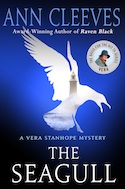
The latest Vera Stanhope mystery, The Seagull by Ann Cleeves (Minotaur), holds a particularly tasty treat: a welcome and more intensive glimpse of the life and times of Vera’s father, Hector. An avid bird-and-egg collector — not entirely legally, mind — Hector ran around with an unsavory but untouchable bunch, including a high-level police officer, a wily wheeler-dealer dude, and a posh gentleman known only as “the Prof.” He also, as it turns out, managed to be an even grumpier grump than Vera, outshining her curmudgeonly reputation on several counts. Vera handles the family baggage surprisingly well as she delves into a long-hidden unsolved mystery, tackling old-school corruption, organized crime, and a local town’s earlier heyday as a seaside resort.

Sarah Pinborough’s Behind Her Eyes, with its heart-stopping twists and highly unreliable narrators, was one of this year’s most whiplash-inducing, adult psychological-suspense novels. With 13 Minutes (Flatiron), Pinborough returns to her YA stomping grounds, and spins teenagers’ tenterhooks and the toxicity of high school into a mind-teasing thriller. Natasha, Hayley, and Jenny are the Barbies, their version of similar cliques portrayed cinematically in Mean Girls and Heathers. But when Tasha nearly drowns and re-friends her childhood bestie, Becca, the stage is set for teen-angst-fuelled intrigue, sex, drugs, and, perhaps, even murder. Just for fun, cast the characters with your preferred actors — film rights have already been sold to Netflix.
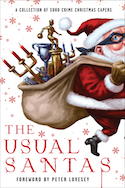
The holiday-infused collection The Usual Santas (Soho Crime), gathers the cream of Soho’s international crime-writing crop, from Stuart Neville and Cara Black, to Helene Tursten and Ed Lin. There’s a canny little heist scene in Cuba from Teresa Dovalpage; a tale of heart-freezing revenge in Manhattan’s Chinatown by Henry Chang; a highly-debatable good-deed-done tale in a remote American ski hamlet by Tod Goldberg; a trip to 16th Century Italy by Gary Corby; and a visit to Jane Austen’s Bath by Stephanie Barron. With a festive multitude of short-story gems to choose from, the honor of best line resides in the book’s eponymous narrative from spy-writing master Mick Herron, in which a plethora of shopping-center Santas, whooping it up on Christmas Eve, realize that something is not quite right: “There’s an elf behind this,” said [one of the Santas]. “Mark my words.”
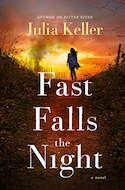
Julia Keller tackles one of the biggest crimes currently being committed in America in Fast Falls the Night (Minotaur). The devastating, destructive opioid crisis drives this novel, localized in Acker’s Gap, West Virginia, but recognizable across the country. Over a single night and day, as multiple victims succumb to an often-fatal batch of heroin, Prosecutor Bell Elkins and her colleagues race against time to discover the source. Keller delineates the infinite and highly personal experiences impacted by drug addiction – in a town this small, no one is unaffected — as she captures the hopelessness, the stifling, dead-end atmosphere of the situation, and the determination of a bold few to address the crisis while secreting several mysteries of their own.
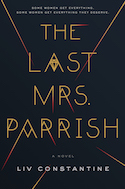
Amber Patterson is onto a good thing in The Last Mrs. Parrish by Liv Constantine (Harper). She’s insinuated herself into the life of the outrageously wealthy Mrs. Daphne Parrish by devious means, angling to replace her as the next Mrs. Parrish ASAP. What stands in her way? Just two suspicious young daughters, Bella and Tallulah, and the conscience of Daphne’s husband, Mr. Jackson Parrish, who clearly adores his wife. In the Parrish family’s opulent, water-front mansion, in their luxurious Manhattan apartment, in Jackson’s beloved motorboat – everywhere the family turns, there Amber is, transforming herself from mousy and timid to glam and glorious, right before their eyes. The latest in a wildly proliferating line of sociopathic characters convinced they are smarter than everyone around them, this is a pleasurably soap-opera-ish thriller from two sisters, Lynne and Valerie Constantine, who clearly had a good deal of fun putting this tale together.
The Quintessential Interview: Joe Ide
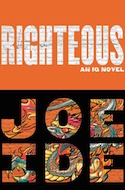
Private eye Isaiah Quintabe’s beat is a rough-and-ready L.A. neighborhood; his best friend and sort-of-partner, Dodson, is about to become a father; and IQ’s determination to solve the decade-old homicide of his older brother is gathering heat. Thus opens Righteous (Mulholland Books), Joe Ide’s second fiery IQ novel in which, to add grist to the investigative mill, Sarita, his brother’s former girlfriend, reaches out for his help, generating an inquiry that encompasses the seamier underbelly of Las Vegas as well as inter-gang warfare. IQ’s smarts serve him in good stead, and it’s excellent fun to watch sidekick Dodson’s resolution to keep up. The other latest reason that Joe Ide is in the news: IQ, Ide and Isaiah’s debut, just won the Anthony Award for Best First Novel.
What or who are your top five writing inspirations?
- Walter Mosley. The original cool breeze. He taught me that it was possible to write a book about an environment like ours and people like the ones we knew, and that there was a readership who would enjoy it. Also, he created Easy Rawlins, the second, original cool breeze. Mosley also taught me that you can wear a fedora and a T-shirt to a black-tie event.
- Elmore Leonard because he writes about lowlifes that are so real they slap you in the face and his dialogue is the best ever.
- John le Carré. I love his precision and intricacy and the tension he creates without violence. He also came up with my third favorite character of all time, just behind Sherlock Holmes and Christopher Robin: the quixotic, emotionally disabled, brilliant George Smiley.
- Don Winslow. He’s just good, that’s all.
- And a tie between Janet Fitch and Mary Karr. Mary Karr for her hilarious, tragic, trailer-trash, so-true-it-hurts biographies, and the writing, the writing. And Janet Fitch for her deeply felt quintessential L.A. novels about quintessential LA characters and the writing, the writing.
Top five places to write?
There are only two. My study with the shutters closed and the door shut and ear plugs in my ears, and the dog underneath the desk as a foot rest. And my outdoor office: a wooden table in the shade of the maple tree and underneath the hummingbird feeder where I am occasionally interrupted by my friend, Hummie (I’m good with names) who is quite used to me now, the dog lying in the cool, damp spot underneath the ferns.
Top five favorite authors?
Elmore Leonard, Walter Mosley, John le Carré, Hunter S. Thompson and A.A. Milne.
Top five tunes to write to?
No music. I’ll sing along or bob my head or tap my foot and I have enough trouble focusing as it is.
Top five hometown spots?
At the moment, Tacos Por Favor; Petty Cash Taqueria; Los Originales Tacos Arabes de Puebla; Sushi Sasabune; and the park along the bluffs in the Palisades overlooking Santa Monica Bay.